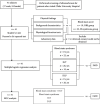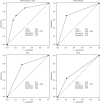Role of Blood Stasis Syndrome of Kampo Medicine in the Early Pathogenic Stage of Atherosclerosis: A Retrospective Cross-Sectional Study
- PMID: 34135979
- PMCID: PMC8175131
- DOI: 10.1155/2021/5557392
Role of Blood Stasis Syndrome of Kampo Medicine in the Early Pathogenic Stage of Atherosclerosis: A Retrospective Cross-Sectional Study
Abstract
In Kampo medicine, blood stasis (BS) syndrome is strongly associated with microangiopathy and can lead to atherosclerosis. Vascular endothelial dysfunction (VED), evaluated through flow-mediated dilation (FMD), plays an important role in the early stages of atherosclerosis. However, the association of BS syndrome with VED, as determined using FMD, has not been reported. This study investigated the association between BS syndrome and VED using FMD. Forty-one patients with normal glucose tolerance or impaired glucose tolerance (IGT) and without macrovascular complications were evaluated using FMD from May 2017 to August 2017. Based on the BS score, the patients were divided into the non-BS (n = 19) and BS syndrome (n = 22) groups. Physical and background characteristics, physiological function test results, and laboratory data were compared. Univariate analysis revealed that FMD and a history of dyslipidemia/IGT were significantly different between the two groups (p < 0.05). Multiple logistic regression analysis showed that BS syndrome was significantly associated with FMD (odds ratio: 6.26; p=0.03) after adjusting for the history of dyslipidemia/IGT. The receiver operating characteristic curve showed that the area under the curve for BS syndrome (0.74; p < 0.001) and history of IGT (p < 0.007) provided good diagnostic accuracy for FMD. The area under the curve for "BS syndrome + IGT" showed very good accuracy (0.80; p < 0.0001) and was higher than that for BS syndrome or IGT alone. In conclusion, the results of this study suggest that the BS score in Kampo medicine could be a useful tool for detecting the early pathogenic stages of atherosclerosis.
Copyright © 2021 Akira Morita et al.
Conflict of interest statement
The authors declare that there are no conflicts of interest regarding the publication of this article.
Figures


Similar articles
-
The antioxidant alpha-lipoic acid improves endothelial dysfunction induced by acute hyperglycaemia during OGTT in impaired glucose tolerance.Clin Endocrinol (Oxf). 2008 May;68(5):716-23. doi: 10.1111/j.1365-2265.2007.03099.x. Epub 2007 Dec 7. Clin Endocrinol (Oxf). 2008. PMID: 18070144 Clinical Trial.
-
Assessment of Endothelial Function in Iranian Healthy Obese Patients after Bariatric Surgery.Adv Biomed Res. 2022 Dec 26;11:118. doi: 10.4103/abr.abr_250_21. eCollection 2022. Adv Biomed Res. 2022. PMID: 36798922 Free PMC article.
-
Insulin resistance and endothelial dysfunction in smokers: effects of vitamin C.Am J Physiol Heart Circ Physiol. 2000 Sep;279(3):H1172-8. doi: 10.1152/ajpheart.2000.279.3.H1172. Am J Physiol Heart Circ Physiol. 2000. PMID: 10993781 Clinical Trial.
-
[Effect of plasma glucose on the vascular endothelial function and analysis of relevant factors].Zhong Nan Da Xue Xue Bao Yi Xue Ban. 2006 Dec;31(6):830-3. Zhong Nan Da Xue Xue Bao Yi Xue Ban. 2006. PMID: 17213577 Chinese.
-
Associations between parameters of flow-mediated vasodilatation obtained by continuous measurement approaches and the presence of coronary artery disease and the severity of coronary atherosclerosis.Clin Exp Hypertens. 2016;38(5):443-50. doi: 10.3109/10641963.2016.1163365. Epub 2016 Jun 30. Clin Exp Hypertens. 2016. PMID: 27359079
Cited by
-
UPLC-G2Si-HDMS Untargeted Metabolomics for Identification of Yunnan Baiyao's Metabolic Target in Promoting Blood Circulation and Removing Blood Stasis.Molecules. 2022 May 17;27(10):3208. doi: 10.3390/molecules27103208. Molecules. 2022. PMID: 35630682 Free PMC article.
-
Significance of traditional herbal medicine for dyslipidemia.Am J Transl Res. 2023 Aug 15;15(8):5373-5388. eCollection 2023. Am J Transl Res. 2023. PMID: 37692941 Free PMC article. Review.
-
A Potential In Vitro 3D Cell Model to Study Vascular Diseases by Simulating the Vascular Wall Microenvironment and Its Application.Life (Basel). 2022 Mar 15;12(3):427. doi: 10.3390/life12030427. Life (Basel). 2022. PMID: 35330178 Free PMC article.
-
A Direct Relationship Between 'Blood Stasis' and Fibrinaloid Microclots in Chronic, Inflammatory, and Vascular Diseases, and Some Traditional Natural Products Approaches to Treatment.Pharmaceuticals (Basel). 2025 May 12;18(5):712. doi: 10.3390/ph18050712. Pharmaceuticals (Basel). 2025. PMID: 40430532 Free PMC article. Review.
References
LinkOut - more resources
Full Text Sources

